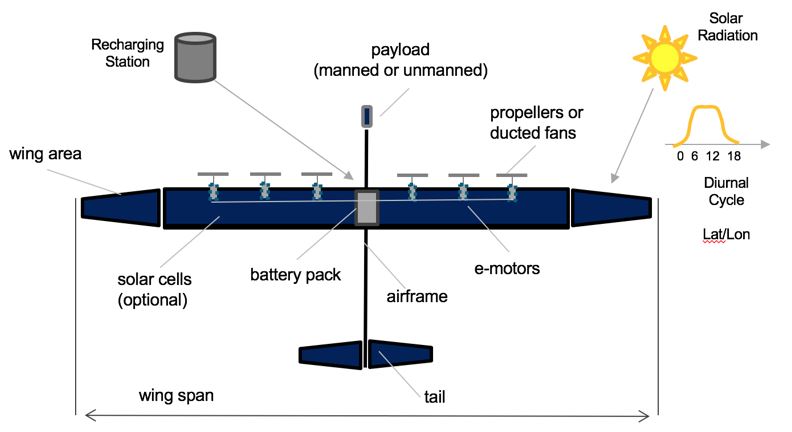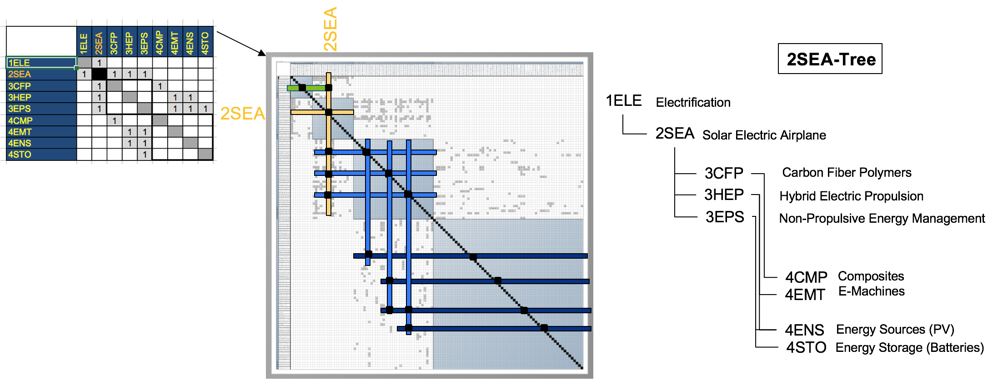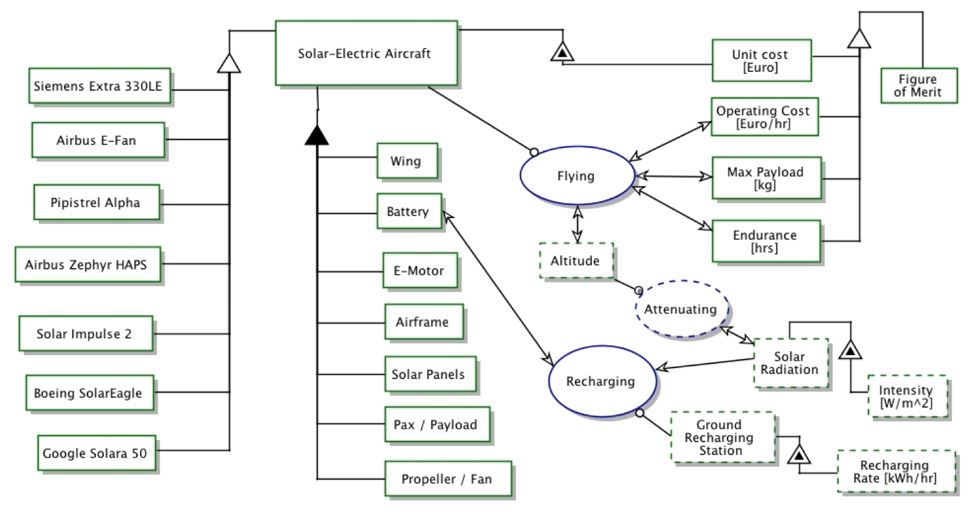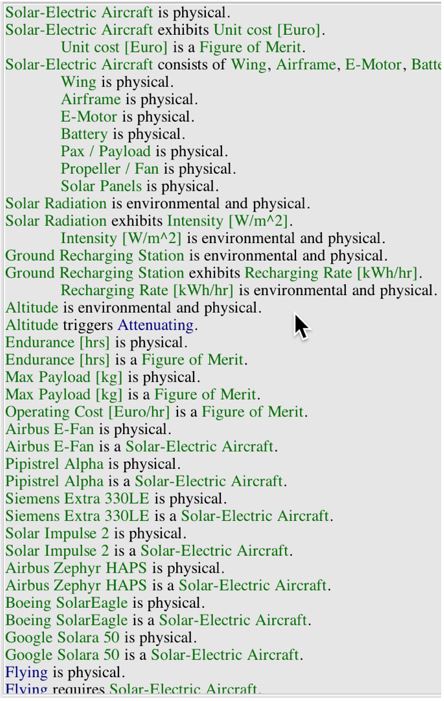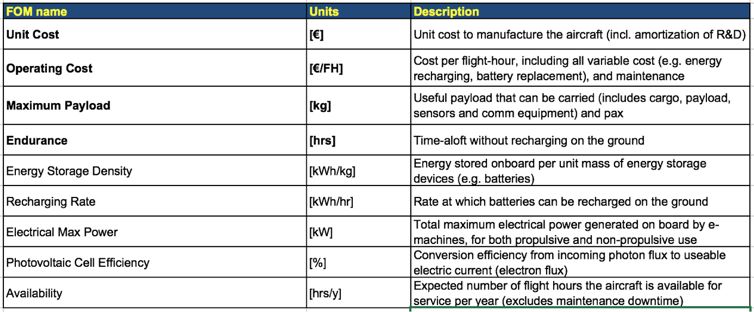Main Page
Getting started
- User's Guide for information on using the wiki software.
- Configuration settings list
- MediaWiki FAQ
Class Project - Technology Roadmaps
Below, each team will create a page for their technology roadmap which will be built up as the semester progresses. For an example, see the Sample Technology Roadmap below taken from Chapter 8 of the text. You may use this sample as a template and also as a guide for how to edit/format your own wiki page, but please be sure NOT to edit the Sample Technology Roadmap, simply copy over any desired formatting, headers, etc. over to your project page.
Sample Technology Roadmap - Solar Electric Aircraft, by de Weck, Haji and Trujillo
We provide a notional technology roadmap for solar-electric aircraft as a potential new business category. The potential market and business applications for this type of aircraft, also known as High-Altitude-Pseudo-Satellites (HAPS) includes military surveillance, civilian research and observation, and radio communications relays, amongst others.
MIT 16.887-EM.427 Fall 2020 Course
We will be using this wiki platform to record progress on the semester-long technology roadmapping projects completed in teams of two. As you progress through your projects, be sure to keep your project pages up to date as each Assignment calls for. Also, be sure to have back ups of the information you place on your project page to avoid any accidental deletions that may occur from joint editing of a wiki (however, this can be more easily avoided by only editing your project's page, and not this main page or any other team's).
If you have trouble editing the wiki, please let us know.
Space Booms, by Browder and Ehn
A Technology Roadmap for the least glamorous space technology, Space Booms! Space Booms are structures used to position space instruments in relationship to the primary mission vehicle. These may not seem like amazing pieces of technology, but they have a storied history of enabling space instrumentation by providing the right geometry, relationships, support, and protection. Space Booms definitely have a bright future.
Earth Observation Satellites, by Bullock and Murray
Mining the Martian Surface for in Situ Resources, by Forsey-Smerek, Kothakonda and Schultz
Laser Confined Nuclear Fusion, by Fry and Hui
We provide a technology roadmap for laser-based confined nuclear fusion technology systems that fundamentally consists of fusing atoms to form heavier ones with a release of energy through neutrons. One of the main technology branches for demonstrating fusion power is Inertial Confinement Fusion, ICF which involves rapidly compressing a D-T (Deuterium-Tritium) fueled target pellet using some of the world’s most powerful lasers.
Smart Grid Home Area Network for Dynamic Pricing and Demand Management, by Kulkarni, Ozturk, Toeldte
The proposed smart grid system uses data from sensors at the Home Area Network (HAN) level to make optimal dynamic pricing decisions for electricity, as well as modulating the power consumption of smart devices.
PHA (polyhydroxyalkanoate) bioplastics manufacturing, by Rajasekaran and Murad
The problem of plastic accumulation in the natural environment is becoming a high profile problem. This is because oil-based plastics, while they are cheap and have good material properties, do not biodegrade. There is a class of bio-derived, biodegradable polymers called PHAs that have the potential to match oil-based plastics, but they currently are not competitive on a cost basis with oil-based plastics due to the high cost of manufacturing them. We propose a technology roadmap to reduce the cost of manufacturing PHA to parity or better with oil-based plastics.
Healthcare Data Security, by Hecht and Spiewak
WorldWide eVTOL, by Yash Trivedi, Farri Gaba & Michael Strauch
eVTOLS (electric Vehicle Take Off and Landing) are airborne vehicles that use electric vectored thrust to take off vertically and transition from vertical thrust to horizontal thrust, ,thus making it flexible and efficient for Urban air commute. The vectored thrust eVTOLs have a wing for an efficient cruise and use the same propulsion system for both hover and cruise.
Electric Vehicle Charging Technologies, by Chafekar, Fischer
Integrated and Co-located Pumped Hydro Reverse Osmosis Systems, by Bahl Chambi, Fant
Integration and co-location of three mature technologies, pumped elevated hydro storage, hydro power generation, and reverse osmosis desalinization, symbiotically enable efficient renewable power storage, power generation and fresh water production. In a world that demands reliable renewable energy sources and faces widespread fresh water shortages, this technology integration could harness significant efficiencies and cost savings.
Team 12
Recommendation Systems
In-Situ Power Generation for AUVs, by Tuinstra, Shoji, and Schlessinger
In-situ power generation for autonomous underwater vehicles (AUV) explores the technology required to enable persistent observation of all areas of the ocean by harvesting free environmental wind, solar, wave, and/or thermal energy and converting it into usable power to enable uninterrupted AUV remote sensing operations.
Team 15
Mining Critical Materials from Seawater and Brine, by Chan, Robinson and Smith
There are a variety of potential sources of lithium globally including minerals (e.g. clay, seawater, etc.); lithium-ion battery recycling; and saltwater brines (e.g. geothermal, continental, salt lakes, oil fields, etc.). We are focused on exploring lithium extraction from geothermal brines. We are roadmapping a sorbent technology that extracts lithium from geothermal brines with a focus on how this technology can be applied to geothermal plants in Southern California.
Retail Payment system, by Jansen van Rensburg and Sugio
Payments Systems are becoming faster and more real-time in this digital age. There is a clear trend towards increasing digital payments, which is replacing physical cash and checks. This is a roadmap that seeks to identify the technical innovation that could occur within the sector, that will also be supported by a more enabling regulatory framework.
Autonomous Underwater Vehicle, by Jain and Yasuhara
Throughout history, the ocean has been a vital source of sustenance, transport, commerce, growth, and inspiration. Yet for all of our reliance on the ocean, more than eighty percent of this vast, underwater realm remains unmapped, unobserved, and unexplored. AUVs provide great opportunities for exploring our oceans. An autonomous underwater vehicle (AUV) is a robot that travels underwater without requiring input from an operator.
Small Launch Vehicles, by Sirieys, Novak
Technology Roadmap Sections and Deliverables
The first point is that each technology roadmap should have a clear and unique identifier:
- 2SEA - Solar Electric Aircraft
This indicates that we are dealing with a “level 2” roadmap at the product level (see Fig. 8-5), where “level 1” would indicate a market level roadmap and “level 3” or “level 4” would indicate an individual technology roadmap.
Roadmap Overview
The working principle and architecture of solar-electric aircraft is depicted in the below.
Solar-electric aircraft are built from light-weight materials such as wood or carbon-fiber reinforced polymers (CFRP) and harvest solar energy through the photoelectric effect by bonding thin film solar cells to the surface of the main wings, and potentially the fuselage and empennage as well. The electrical energy harvested during the day is then stored in on-board chemical batteries (e.g. Lithium-Ion, Lithium-Sulfur etc…) and used for propelling the aircraft at all times, including at night. For the system to work there needs to be an overproduction of energy during the day, so that the aircraft can use the stored energy to stay aloft at night. The flight altitude of about 60,000-70,000 feet is critical to stay above the clouds and not to interfere with commercial air traffic. Depending on the length of day, i.e. the diurnal cycle which determines the number of sunshine hours per day, which itself depends on the latitude and time-of-year (seasonality) the problem is easier or harder. The reference case in the technology roadmap is an equatorial mission (latitude = zero) with 12 hours of day and 12 hours of night.
Design Structure Matrix (DSM) Allocation
The 2-SEA tree that we can extract from the DSM above shows us that the Solar-Electric Aircraft (2SEA) is part of a larger company-wide initiative on electrification of flight (1ELE), and that it requires the following key enabling technologies at the subsystem level: 3CFP Carbon Fiber Polymers, 3HEP Hybrid Electric Propulsion and 3EPS Non-Propulsive Energy Management (e.g. this includes the management of the charge-discharge cycle of the batteries during the day-night cycle). In turn these require enabling technologies at level 4, the technology component level: 4CMP components made from CFRP (spars, wing box, fairings …), 4EMT electric machines (motors and generators), 4ENS energy sources (such as thin film photovoltaics bonded to flight surfaces) and 4STO (energy storage in the form of lithium-type batteries).
Roadmap Model using OPM
We provide an Object-Process-Diagram (OPD) of the 2SEA roadmap in the figure below. This diagram captures the main object of the roadmap (Solar-Electric Aircraft), its various instances including main competitors, its decomposition into subsystems (wing, battery, e-motor …), its characterization by Figures of Merit (FOMs) as well as the main processes (Flying, Recharging).
An Object-Process-Language (OPL) description of the roadmap scope is auto-generated and given below. It reflects the same content as the previous figure, but in a formal natural language.
Figures of Merit
The table below show a list of FOMs by which solar electric aircraft can be assessed. The first four (shown in bold) are used to assess the aircraft itself. They are very similar to the FOMs that are used to compare traditional aircraft which are propelled by fossil fuels, the big difference being that 2SEA is essentially emissions free during flight operations. The other rows represent subordinated FOMs which impact the performance and cost of solar electric aircraft but are provided as outputs (primary FOMs) from lower level roadmaps at level 3 or level 4, see the DSM above.
Besides defining what the FOMs are, this section of the roadmap should also contain the FOM trends over time dFOM/dt as well as some of the key governing equations that underpin the technology. These governing equations can be derived from physics (or chemistry, biology ..) or they can be empirically derived from a multivariate regression model. The table below shows an example of a key governing equation governing (solar-) electric aircraft.
MIT 16.887-EM.427 Fall 2019 Course
Ballistic Vests, by Li and Lew
This technology is a lifesaving technology to aid military personnel and law enforcement during their daily activities. Ballistic Vests have various ratings for the level of protection and a myriad of different materials are used to absorb the kinetic energy of the projectile threat. We are focusing on the materials used in ballistic vests.
Plant Genetic Improvement, by Lordos, Smith and Slominski
Humans have been improving the genome of useable plants for millenia through unintentional, and later intentional selection. The last 100 years have seen increasing advances in artificial methods to improve the genetics of useful plants through increasingly scientific approaches.
Satellite Data Communication, by Robinson, Wan, and Wilson
Satellite-based internet/voice access is enabled by satellites, which provide relay to extend communication beyond traditional (terrestrial) line of site of the network and users. Data encoded in radio waves is sent between the ground station’s transceiver, relayed via the satellite, and the modem at the user’s location. Advances in technology include High Throughput Satellites (HTS) and some next-generation satellite systems may follow low-earth orbit rather than geosynchronous orbits, which would reduce latency dramatically.
In-Space Additive Manufacturing, by Lee, Mandal, and Moraguez
In-space additive manufacturing involves the fabrication, assembly, and integration of components beyond Earth’s atmosphere. Technologies in this area focus on fabricating a product with improved performance or reduced cost compared to existing Earth-fabricated products using manufacturing equipment with a rapid production rate, long life, and low size, weight, and power (SWaP). The additive manufacturing units use the layer-wise deposition of material to build up required component geometries. The energy source for the addition of material can either be mechanical, thermal, electrical, or chemical. For in-space additive manufacturing to prove viable, it must be possible to fabricate a variety of components in the required materials and geometries while meeting requirements on tolerances, surface roughness, and lead time. The reference case in the technology roadmap is the manufacturing of spare parts for a roundtrip Mars mission.
Wind Turbine - Energy Harvesting, by Wainer, Sakhamuru, and Fukatsu
Wind energy is one solution to changing over to a cleaner energy source than carbon dense fuel power plants. By harnessing the kinetic energy of the air around us, and transforming it into electricity, wind turbines can relieve some of the power needs of the growing population.
Autonomous System for Ground Transport, by Chun and Yang
The autonomous system for ground transport has been surging in the last decade but also possesses an origin dated almost a century back. It is a technology that has not just historical information but also referential data since it has been employed in other analogous systems such as autopilot on airplanes. By reviewing relevant metrics and evaluating technology readiness level, we construct roadmap for autonomous system for ground transport in order to collect insights and illustrate guidance on where and how this technology will move forward.
Mixed Reality (Augmented & Virtual), by Baylor and LeBlanc
Augmented, virtual, and mixed realities reside on a continuum and blur the line between the actual world and the artificial world. We offer a roadmap to explore the relationships of this technology, align capabilities to future market needs, and define a timeline for technology maturation and adoption.
Energy Storage via Battery, by Cadario, Johnson, and Tamura
A battery is an assemblage of cells (containing two electrodes, an electrolyte traditionally liquid, embedded in a housing) connected electrically to provide voltage and current. Simple, isn't it?! We focus on Lithium-ion batteries, which have taken the world of electronic devices since the 90's, are booming for transportation uses, and which still provide formidable challenges in a long-term improvement perspective.
Orbital Launch Vehicles Roadmap, by Heilbrun, Horton, and Kharsansky
Orbital launch vehicles (LV) are internally rocket-propelled vehicles used to carry payloads from Earth’s surface to low earth orbit and beyond. This roadmap explores the capacity that the Human race has to put payloads in orbit as a technology enabler for future space and planetary exploration.
High-Speed Rail Safety, by de Filippi, Kimura, and Soeda
High-Speed Rail is a classification of a passenger rail transportation system that operates at high-speed with high voltage electricity. The International Union of Railways defines high-speed rail as systems of rolling stock and infrastructure which regularly operate at or above 250 km/h on new tracks, or 200 km/h on existing tracks. Currently, rolling stock obtains electricity for propulsion is operated by a driver who follows signals and communicates with one or more control center(s).
Online Reverse Procurement Marketplaces and Auctions, by Ravenel and Goolsby
Online reverse procurement marketplaces and auctions are online marketplaces and auctions where service providers bid on different service requests from people and companies in need of contract work. Examples include Upwork, Mechanical Turk, and other industry specific markets and auctions.
Sparse Apertures for Next Generation Optical Space Telescopes, by Chris and Michael
The angular resolution of a telescope is proportional to the size of the aperture. The mass and thus cost of space telescopes increases exponentially with aperture diameter. There is a need for systems that can produce the equivalent of a large aperture with low mass.
Remote Operated Processing Platform, by Asa, Johnson, Rahill
Remote Operated Processing Platform for Offshore Oil and Gas
Random Forest in Data Analytics, by Yang and Muramoto
Random Forest is an ensemble Machine Learning technique to boost the accuracy of prediction for future based on the past
Rocket Engines, by Heilbrun and Horton
Rocket engines have been evolving from their humble beginnings as fireworks since the year 900. In this section, we address the history, inspiration, design, and evolution of rocket engines. We conclude with in-depth discussions of figures of merit and their change over time. Rocket engines are the enabling technology for the growing field of space commerce. Their evolution will arguably enable the future of commercialization of near-earth and more distant markets.
Computer-Aided Detection Leveraging Machine Learning and Augmented Reality, by Nestor Figueroa, Masato Kawano, and Tiago Koga
Augmented reality and artificial intelligence are complementary technologies. Smaller, faster, and more accurate AI models will be the engines of AR functionality, given their ability to track and understand the 3D world. AI will also continue to enhance AR experiences, adding effects and interactivity to AR scenes. Applications like: image and scene labeling, object detection, semantic segmentation and occlusion, pose estimation, text recognition and translation, audio recognition. There are tremendous applications in medicine, construction and urban planning, entertainment, security, among others.
In Space Propellant Depot, by (Tom)Tomohisa Okamoto, Gautam Madhivanan
“As early as 1928, scientists studying interplanetary travel began arguing that pre-positioning propellants in orbit would be required for any sustainable large-scale travel beyond Earth.”[1] In space propellant depots sustain cryogenically cooled fuels and oxidizers like liquid hydrogen and liquid oxygen. External sources of heat coming from the sun, solar energy reflected from the earth and IR emitted from the earth need to be mitigated using solar shields. In order to prevent the liquid propellent from becoming gas cyro-coolers powered by solar panels can be used as well.
Smart 3D Cameras, by Enti
3D Cameras are a class of low-cost depth sensors that are used in robotics, gaming and autonomous cars for perceiving the environment and detecting and identifying objects. The 3D camera system creates 3D point clouds of the environment and provides camera pose information which is then used by connected sub-systems for mapping, autonomous navigation. This roadmap captures the evolution of 3D camera technology from passive stereo cameras and structured light to smart stereo cameras.
Note: the rest of your roadmap goes in your project page which can be created by following how the sample roadmap page is created above. Click the Edit tab above and find the Sample Technology Roadmap section...you will see that a double bracket enclosing a phrase will automatically create an empty page with that name.
